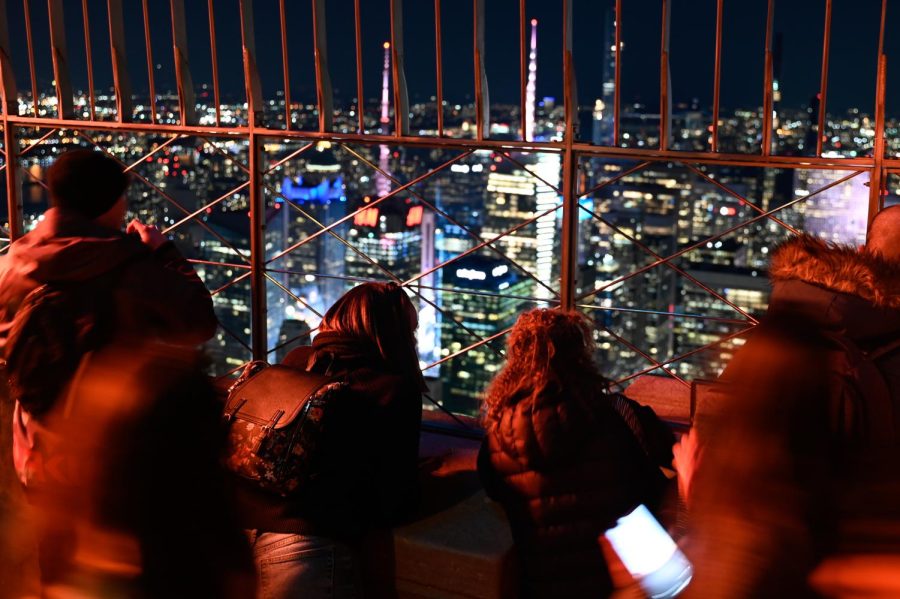Highest of high-rises
The Empire State Building towers above its Gatsby-esque hometown
The Empire State Building stands above New York City. Harker journalism visited the attraction during the CSPA Spring Convention, traveling all the way up to the 102nd floor.
March 18, 2023
NEW YORK — A cold breeze washes over a line of people huddled around the balcony of the 86th story of the Empire State Building. Just beyond the metal bars lies a breathtaking nighttime view of New York City, dancing lights dotting the metropolitan landscape like stars in the midnight sky.
In front of a sparkling champagne mosaic of the building, a guide waves the crowd down a path of inlaid art and deco on the floor. Glowing in dusky shades of pink and blue, an ivory miniature of the building is a reminder of what is to come. Just through lengthy lines of security, rooms upon rooms of black and white photos of the building’s construction, recreations of the building, and posters of famous movies filmed in the building lead to the elevators. As the brass-embellished doors open on the 86th floor, vibrant city lights flash against the backdrop of the dark sky, like fireflies shouting their greetings.
“Going outside to the observation deck was a good departure from spending a ton of time inside the building waiting in lines and being crowded in elevators,” Assistant Sports Editor Kevin Zhang (11) said. “It was fun experiencing the environment with other people also enjoying the view. Walking around the building and looking at the city from different angles allows you to see some really unique sights.”
Another short journey on a custom-made glass elevator ends on the 102nd floor, the uppermost floor of the building. From within the 360-degree glass observation deck, the view extends for miles throughout the cityscape. After enjoying their fill of selfies and pensive gazes, visitors exit via a series of elevators before finally returning once more to the ground.
The dawn of the 1930s marked the beginning of the Empire State Building’s construction, with over 3,000 workers laboring to turn the skyscraper into the world’s tallest building. In the midst of the Great Depression, the Empire State Building not only provided jobs for the unemployed but also gave Americans hope for a brighter and more prosperous future, according to tour guide Gordon Blair.
“The purpose of the Empire State Building is to represent prestige, power and American ingenuity,” Blair said. “While the Statue of Liberty was viewed as a symbol of freedom, the Empire State Building was power. When we constructed the building during the Great Depression, we wanted to show the world what we were still capable of.”
The Empire State Building first opened to the public in 1931, just over a year after its construction began. As one of the largest office spaces in the world in bustling New York City, the tower served the dual purpose of commerce and tourism for the American public. The Empire State Building offered tourists a new, expansive view of the city, and the single antenna crowning the skyscraper provided the first ever radio and television services.
“The top of the Empire State Building was actually originally built to dock blimps,” Blair said. “When the Hindenburg disaster happened, we decided to switch gears and put an antenna at the top of the building, which was the first antenna to broadcast radio and television.”
Almost a century later, the Empire State Building still remains a cultural icon, a single, distinct beacon amidst the sea of dwarfed structures. With now over 4 million visitors every year, one of the tallest skyscrapers in the country has cemented itself in American history, one floor at a time.


















![“[Building nerf blasters] became this outlet of creativity for me that hasn't been matched by anything else. The process [of] making a build complete to your desire is such a painstakingly difficult process, but I've had to learn from [the skills needed from] soldering to proper painting. There's so many different options for everything, if you think about it, it exists. The best part is [that] if it doesn't exist, you can build it yourself," Ishaan Parate said.](https://harkeraquila.com/wp-content/uploads/2022/08/DSC_8149-900x604.jpg)




![“When I came into high school, I was ready to be a follower. But DECA was a game changer for me. It helped me overcome my fear of public speaking, and it's played such a major role in who I've become today. To be able to successfully lead a chapter of 150 students, an officer team and be one of the upperclassmen I once really admired is something I'm [really] proud of,” Anvitha Tummala ('21) said.](https://harkeraquila.com/wp-content/uploads/2021/07/Screen-Shot-2021-07-25-at-9.50.05-AM-900x594.png)







![“I think getting up in the morning and having a sense of purpose [is exciting]. I think without a certain amount of drive, life is kind of obsolete and mundane, and I think having that every single day is what makes each day unique and kind of makes life exciting,” Neymika Jain (12) said.](https://harkeraquila.com/wp-content/uploads/2017/06/Screen-Shot-2017-06-03-at-4.54.16-PM.png)








![“My slogan is ‘slow feet, don’t eat, and I’m hungry.’ You need to run fast to get where you are–you aren't going to get those championships if you aren't fast,” Angel Cervantes (12) said. “I want to do well in school on my tests and in track and win championships for my team. I live by that, [and] I can do that anywhere: in the classroom or on the field.”](https://harkeraquila.com/wp-content/uploads/2018/06/DSC5146-900x601.jpg)
![“[Volleyball has] taught me how to fall correctly, and another thing it taught is that you don’t have to be the best at something to be good at it. If you just hit the ball in a smart way, then it still scores points and you’re good at it. You could be a background player and still make a much bigger impact on the team than you would think,” Anya Gert (’20) said.](https://harkeraquila.com/wp-content/uploads/2020/06/AnnaGert_JinTuan_HoHPhotoEdited-600x900.jpeg)

![“I'm not nearly there yet, but [my confidence has] definitely been getting better since I was pretty shy and timid coming into Harker my freshman year. I know that there's a lot of people that are really confident in what they do, and I really admire them. Everyone's so driven and that has really pushed me to kind of try to find my own place in high school and be more confident,” Alyssa Huang (’20) said.](https://harkeraquila.com/wp-content/uploads/2020/06/AlyssaHuang_EmilyChen_HoHPhoto-900x749.jpeg)










